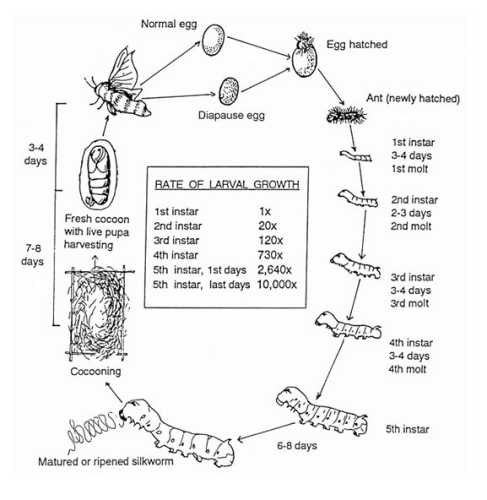https://www.meritnation.com/ask-answer/question/life-cycle-of-a-silk-moth/fibre-to-fabric/4836670
- -17
The female silk moths lays eggs, from which larvae hatch and are called caterpillar or silkworms. the silkworms grow and enter into next stage called pupa. the pupa weaves a net to hold itself. The pupa swings its head in the form of figure 8. During these movements of the head te silkworm secretes fibre made of a protein which harden on exposure to air and becomes silk fibre. Thus Silkworm completely covers itself by silk fibre and turns into pupa. This covering is known as cocoon. The pupa inside the cocoon develops into moth and life cycle of silkworm complets.
- 75

fertilized egg
1st instar larva 3-4 days at 27°C
1st molting
2nd instar larva 2-3 days at 26°C
2nd molting
3rd instar larva 3-4 days at 25°C
3rd molting
4th instar larva 5-6 days at 23°C
4th molting
5th instar larva 6-8 days at 22-23°C
"wandering" stage on day 8th of fifth-instar larvas
spinning - cocooning,cocoon serves as a protection during the vulnerable pupal state; it produced from raw silk secreted by the salivary glands of the silkworm
There are 4 spinning stages:
S0
S1
S2
S3
pupa - pupa is also called chrysalis
imago - complete insect (moth)
newly eclosed - just out of cacoon
adult - mature
There is additional stage if the egg is going to overwinter - "diapausal egg"
- 52
Silk is an animal fibre, which is obtained from silkworms that live on mulberry trees. The rearing of silkworms to obtain silk is known as sericulture. During a stage of its life cycle, the silkworm weaves a net around itself. Silk is then obtained from this net. To get an insight of this process, we will first study the life cycle of a silkworm.

The life of a silkworm starts when a female moth lays eggs on the mulberry leaves. After sometime, these eggs hatch into larvae. These larvae are known as caterpillars or silkworms. Slowly these caterpillars grow in size by feeding only on the leaves of mulberry trees.
The next stage in the life cycle of a silkworm is a pupa. When the caterpillar has grown large enough and is ready to go to the stage of pupa, it starts weaving a net around itself to hold itself. Then, it moves its head from one side to another, making a figure eight (8). During these movements, caterpillars secrete a fibre made of protein, which solidifies and hardens when exposed to air for some time. This is the silk fibre. Caterpillars continue to spin silk fibre till they completely get covered by these fibres. This silk covering in which a silkworm covers itself is known as a cocoon. Further development of the silkworm takes place inside the cocoon, and it enters the pupa stage. After sometime, the pupa enters into the adult stage and emerges out of the cocoon as a moth. The whole process thus continues and is known as the life cycle of a silkworm.
- 31
The life cycle of a silkworm starts when a female silk moth lays eggs on the mulberry leaves andends whenpupa enters into the adult stage and emerges out of the cocoon as a silk moth.

When a female moth lays eggs on the mulberry leaves, after sometime, these eggs hatch into larvae.These larvae are known as caterpillars or silkworms.Slowly these caterpillars grow in size by feeding only on the leaves of mulberry trees.
The next stage in the life cycle of a silkworm is apupa. When the caterpillar has grown large enough and is ready to go to the stage of pupa, it starts weaving a net around itself to hold itself. Then, it moves its head from one side to another, making a figure eight (8). During these movements, caterpillars secrete a fibre made of protein, which solidifies and hardens when exposed to air for some time. This is thesilk fibre. Caterpillars continue to spin silk fibre till they completely get covered by these fibres. This silk covering in which a silkworm covers itself is known as acocoon. Further development of the silkworm takes place inside the cocoon, and it enters the pupa stage. After sometime, the pupa enters into the adult stage and emerges out of the cocoon as a moth. The whole process thus continues and is known as the life cycle of a silkworm.
- 1


